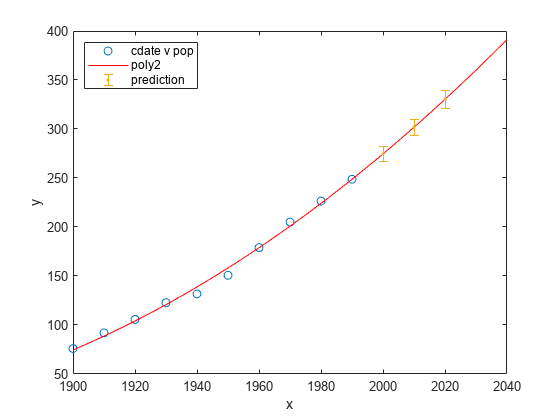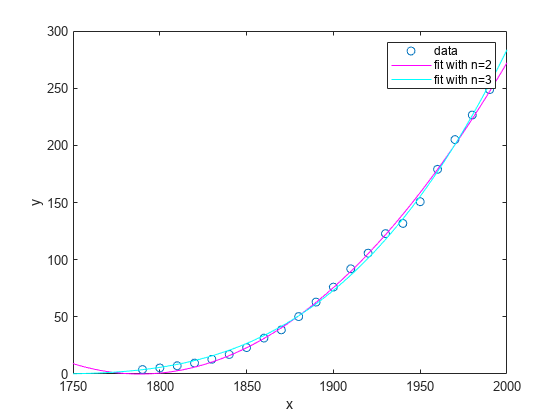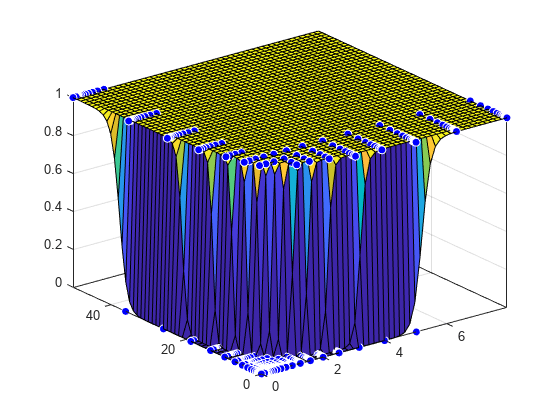线性和非线性回归
用线性或非线性库模型或自定义模型进行曲线或曲面拟合
App
| 曲线拟合器 | 对数据进行曲线和曲面拟合 |
函数
主题
教程
- 参数化拟合
查找曲线拟合器和fit函数的所有库模型类型,设置拟合选项,并优化起点。 - Introduction to Least-Squares Fitting
Perform least-squares fitting by using error distributions and linear, weighted, robust, and nonlinear least squares. - Fit Polynomial Models
Fit polynomials in the Curve Fitter app or with thefitfunction. - 拟合指数模型
在曲线拟合器中或使用fit函数拟合指数模型。 - Fit Logarithmic Models
A logarithmic model has a steep initial period of growth before continuing to grow at a slower rate. - Fit Fourier Models
Fit Fourier series models in the Curve Fitter app or with thefitfunction. - 拟合高斯模型
在曲线拟合器中或使用fit函数拟合高斯模型。 - 拟合幂级数模型
在曲线拟合器中或使用fit函数进行幂级数模型拟合。 - Fit Rational Models
Fit rational polynomial models in the Curve Fitter app or with thefitfunction. - 拟合正弦和模型
在曲线拟合器中或使用fit函数进行正弦和模型拟合。 - Fit Weibull Distribution Models
Fit Weibull distribution models in the Curve Fitter app or with thefitfunction. - Fit Sigmoidal Models
Fit sigmoidal models in the Curve Fitter app or with thefitfunction. - Fit Custom Models
If the Curve Fitting Toolbox library does not contain a desired parametric equation, you can create your own custom equation. - Fit Custom Linear Models
In the Curve Fitter app, you can use the Custom Equation fit to define your own linear or nonlinear equations.
工具工作流
- 交互式曲线和曲面拟合
使用曲线拟合器选择数据和模型类型以进行曲线和曲面拟合,然后保存您的会话。 - 数据选择
在曲线拟合器中选择要拟合曲线和曲面的数据,确定大小兼容的数据并对数据问题进行故障排除。 - Compare Fits in Curve Fitter App
Find the best fit by comparing visual and numeric results, including fitted coefficients and goodness-of-fit statistics. - Surface Fitting to Franke Data
Create and compare surface fits in Curve Fitter app using example data. - Surface Fitting to Biopharmaceutical Data
Curve Fitting Toolbox software provides some example data for an anesthesia drug interaction study. - Custom Nonlinear ENSO Data Analysis
This example fits the ENSO data using several custom nonlinear equations. - Gaussian Fitting with an Exponential Background
This example fits two poorly resolved Gaussian peaks on a decaying exponential background using a general (nonlinear) custom model. - Save Custom Equations and Fit Options
Save custom equations and fit options in the Curve Fitter app.
编程工作流
- Curve and Surface Fitting
Workflow for programmatic curve and surface fitting in Curve Fitting Toolbox. - 曲线和曲面拟合的库模型列表
查找使用fit函数进行编程数据拟合所需的所有 Curve Fitting Toolbox 库模型名称。 - Curve and Surface Fitting Objects and Object Functions
Learn how to create, access, and modify curve and surface fit objects. - 多项式曲线拟合
此示例说明如何使用 Curve Fitting Toolbox 对部分人口普查数据进行最高六次的多项式拟合。 - Fit Polynomial Model to Data
This example shows how to fit a polynomial model to data using the linear least-squares method. - Compare Robust Fitting Methods
This example shows how to fit a polynomial model to data using the bisquare weights, least absolute residuals (LAR), and linear least-squares methods. - 自定义非线性人口普查拟合
此示例说明如何对人口普查数据进行自定义方程拟合,指定边界、系数和问题相关参数。 - 对数据进行指数模型拟合
此示例说明如何使用信赖域和莱文贝格-马夸特非线性最小二乘算法对数据进行指数模型拟合。 - Improve Model Fit with Weights
This example shows how to fit a polynomial model to data using both the linear least-squares method and the weighted least-squares method for comparison. - Surface Fitting with Custom Equations to Biopharmaceutical Data
This example shows how to use Curve Fitting Toolbox™ to fit response surfaces to some anesthesia data to analyze drug interaction effects.


